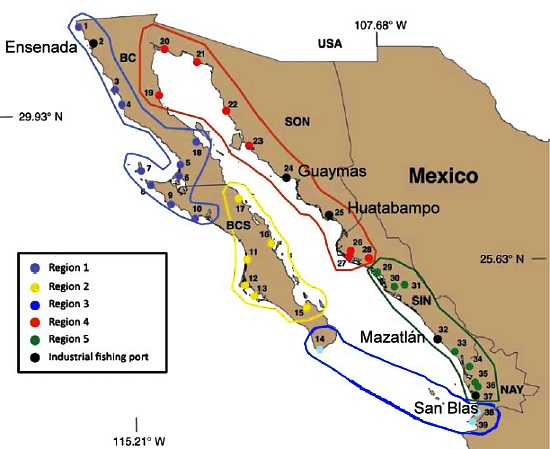Mexico’s fishing industry now accounts for only 0.24% of gross national product. The relatively shallow waters off the Pacific coast and abundance of plankton in waters cooled by the Californian current make for particularly good fishing in the north-west. Together, Sinaloa (23%) and Sonora (22%) account for about 45% of the national total. Fishing is also economically important in Veracruz (8%), Baja California Sur (6%), Campeche and Baja California (5% each) and Yucatán. Almost three quarters (72%) of the total annual catch of 1.5 million metric tons is landed at Pacific coast ports such as Guaymas, Mazatlán and Manzanillo. [excerpt from Geo-Mexico page 97]
A study of fisheries in the region by a team of researchers from the University of California San Diego’s Scripps Institution of Oceanography and the Centro para la Biodiversidad Marina y la Conservación in La Paz, Baja California Sur makes for interesting reading.
The team looked at fisheries data for northwest Mexico, defined as including the coasts of five states: Baja California, Baja California Sur, Sonora, Sinaloa and Nayarit. They conducted field research and then examined the connections between local fisheries data and the geography and habitats of the various fish species. They found a close tie between the geography of local habitats and the (local) decision as to which fish species to catch (clams, red snapper, shrimp). They also found that small-scale local fishing, which relies on thousands of pangas, remains an important component of local economies.
The researchers concluded that the area is not one homogeneous unit, but can be best divided into five overlapping sub-zones (see map) differentiated on the basis of such characteristics as whether the coast is rocky or has mangroves, the presence of reefs or sandy seafloor, the coastal geology and latitude.
Hence, the current fisheries strategy of treating the entire region as a single area is not the most effective way to manage fisheries. According to the researchers, their five-fold zonation would allow “ecosystem-based management” in each sub-region. This would encourage management techniques which ensure long-term conservation of particular fish stocks and help increase fishing’s sustainability.
However, it also requires using different strategies for large-scale industrial fishing than for local, small-scale panga-based activity. The researchers remain optimistic that small-scale fishing has a good future, but only provided industrial-scale fishing is well monitored and controlled.
Source: University of California-San Diego (2011, January 27). Study finds common ground for ecosystems and fishing in Northwest Mexico. Retrieved January 28, 2011.

Sorry, the comment form is closed at this time.